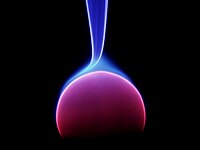
Photo from wikipedia
The impact-induced energy transfer and dissipation in granular targets without any confining walls are studied by microgravity experiments. A solid projectile impacts into a granular target at low impact speed… Click to show full abstract
The impact-induced energy transfer and dissipation in granular targets without any confining walls are studied by microgravity experiments. A solid projectile impacts into a granular target at low impact speed (0.045≤v_{p}≤1.6 m s^{-1}) in a laboratory drop tower. Granular clusters consisting of soft or hard particles are used as targets. Porous dust agglomerates and glass beads are used for soft and hard particles, respectively. The expansion of the granular target cluster is recorded by a high-speed camera. Using the experimental data, we find that (i) a simple energy scaling can explain the energy transfer in both soft-particle and hard-particle granular targets, (ii) the kinetic impact energy is isotropically transferred to the target from the impact point, and (iii) the transferred kinetic energy is 2%-7% of the projectile's initial kinetic energy. The dissipative-diffusion model of energy transfer can quantitatively explain these behaviors.
Journal Title: Physical review letters
Year Published: 2018
Link to full text (if available)
Share on Social Media: Sign Up to like & get
recommendations!